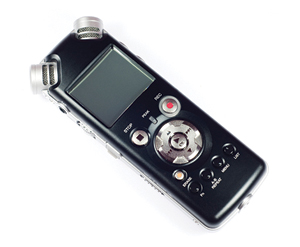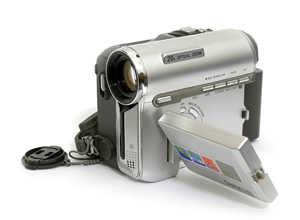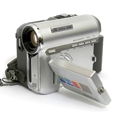I strongly believe in using technological tools to improve flute playing. There are two tools that I consider the most essential: an audio recorder and a video camera. The former could be any device that records a realistic version of how you sound. (I do not recommend cell phones due to their anemic internal microphone.) The latter includes any device to record video, including cell phones.
 Sound Recording Device
Sound Recording Device
Many students are too young to remember when telephone answering machines were completely new, but they became common when I was at university. Although it seems humorous now, initially I felt trepidation at recording an outgoing message and then leaving one for someone else. Speaking to the machine on the other end felt intimidating, and it was even more painful to hear my voice on a recording.
Students today think nothing of leaving voice messages, but I wonder how many record their solitary flute practice. Those who have not done so may experience that cold-sweat feeling when hearing the playback that I had with my first answering-machine. It goes away with experience. I have been recording myself in performance since my first music festival in 6th grade, and during practice sessions since high school. During this time the technology has changed from cassette recorder, to mini-disc, to the portable hard-drive recorder I use today. I input a studio microphone for the most accurate rendering, since I want to hear what my overall tone and color really sound like.
When I am teaching, students often play something that compels me to ask if they ever use a sound recording device. I usually know the answer before I ask is no. I can guess this by certain subtle aspects of their playing which they would quickly hear on a recording. With a little discussion, I can usually get students of any age enthusiastic about using a recording device. Learning increases exponentially once they do because it is like an extra pair of ears available in their practice time when no teacher is present.
Students often do not get off to a good start recording themselves. Either they buy a machine but fail to use it, or they record themselves but do not listen to it. They give assorted reasons and excuses for these failures, but the tool is of no use. It is closer to being useful if they at least record themselves because their hearing suddenly becomes much more acute as they listen to themselves while recording.
The reality is that our courage often fails when it comes to recording and listening to ourselves play. I stumbled through these lapses in my early days. Courage is what is called for here. This noble attribute means pressing forward despite one’s fears or trepidations. It is at first painful to hear oneself from a machine that, for starters, will not offer a single encouraging or hopeful statement in response to how you just played. It will simply play back what you have recorded. I will admit that although I record and listen to myself often, a feeling of anxiety appears in anticipation of what I might hear right at the moment of pushing play. It may be better or worse than I suspect; but it is rarely the same as I had anticipated. What one thinks is happening, and what actually is happening rarely matches. It is a self-confronting moment, and the best thing you can do for yourself is to push play. It is like a free flute lesson.
To muster the courage, I tell myself that I will simply find out what needs improving, and work on it. No self-chastisement is necessary, only focused work. This is the best part of practicing to me: figuring out what is needed, and then coming up with the most efficient method to get there. Imagine that in record mode you are the performer, and in playback mode you are the teacher, listening on an entirely different level. Is the playing consistently in tune? Do the phrases need more architectural shape to them? Is the breathing working? Is there more than one dynamic? Are you getting the precise sound you want on a particular note, or in general?
I have learned to listen to the playback with an open yet analytical frame of mind, and then set to work on happy improvement. After all, it is all simply a moment in time. Nothing sounds great when it is new, and the problems needing work may have only recently been identified. In five days however, all will be vastly improved if you work on it, and just think what a year will give you. This is the magic reward of being a musician: we can actively do something to improve ourselves. Not many vocations allow this deep level of satisfaction and personal control over improvement. It is our daily work, and we can smile at the end of every day. No one will ever play perfectly, but everyone can focus on improving what the last minute sounded like. Of course, we all hope for that great, free feeling when playing straight from the soul comes out exactly as it felt. If it does not, get the tools out and start honing your craft. Add what is needed and whittle away at what does not belong. A recording device will teach you just how to do this.
 Video Camera
Video Camera
The next-best tool is the use of a video camera. I have used one for twelve years now. I started out by borrowing a friend’s state-of-the-art Buick-sized camera with VHS tape. I now have two hard-drive HD video cameras, and use them religiously, especially in practice sessions. As my monitor (playback screen), I use an old 12" television. It can be a revelatory experience to see yourself play and may lead to similar nerves initially. Again, it is a truth-teller about what is, not what we think is happening. You may think you know how you stand, but when busy playing music your posture may gravitate to something different. A video recording will show how you express yourself and what impressions you communicate. Is it strength and confidence, or weakness and fear? You may be expressing things you do not wish to communicate, such as a wince at a wrong note, tired or sloppy posture, a strained face, or lack of enthusiasm for the music. Don’t forget, we are always communicating when we perform. Train to communicate only the information you want to an audience. This training comes from careful listening and watching.
I occasionally video record my students in a lesson. After I have recorded them, I turn the volume completely off for the playback and let them watch their playing. I ask them questions about what they see. What mood are you playing, here? Is it coming across? Does your body change, when the music changes? Is there a sense of playing out to the audience, or into your music stand instead? Are there subtle ways your communication skills can be more deliberate, while remaining natural?
If you don’t own a separate audio recording device, you can use a video camera for both, unless it is just a cell phone which as mentioned before has poor audio quality. If you only have a video camera, I highly recommend that you listen separately to the recording while not viewing the visuals. This will really allow you to focus on the sound and not be distracted by how it looks. It is best to have a separate audio device because the visual element supersedes our ability to really listen deeply, and it is helpful to work separately with these two tools to simplify the information received.
We are fortunate that we are all living in an era when these two machines are so prominent and affordable. They are a teacher you can always have at your fingertips. Use them to learn how to improve your abilities and make the gorgeous music you want with a presentation that will captivate an audience.






